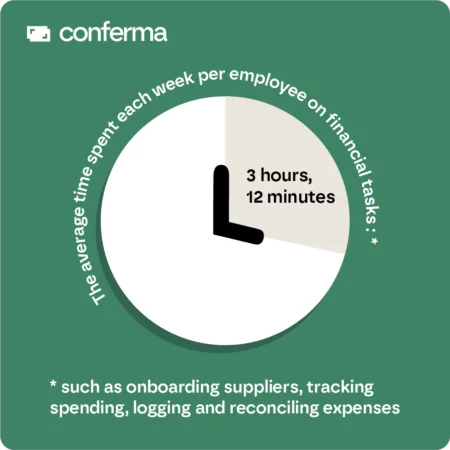As part of episode two of The Payments Insider Podcast, Sabre’s Chief Commercial Officer, Roshan Mendis, and Conferma COO, Dave Wood, explore how virtual card technology is transforming corporate travel.
Reducing financial admin
The average employee spends three hours and twelve minutes each week on financial tasks. That’s almost seven days a year where your employees are distracted from their main priorities.
With financial decision makers identifying operational inefficiencies as the most significant hurdle to business growth, reducing the time spent on these repetitive administrative tasks is critical.
Virtual cards are eliminating the need for lengthy finance admin. As each card is created for a specific purpose, purchase data is automatically matched to payment data, eliminating the need for manual reconciliation post-trip.
Solutions like Conferma’s also offer a single centralised platform for spend management, significantly reducing the time spent consolidating spend data from various trips and expenses. All of which gives your teams more time to focus on what it is they do best.
Minimising fraud risk
Amongst existing users of virtual cards, improved security and reduced fraud risk was reported as the primary benefit. Virtual cards are generated with a pre-agreed amount approved by a manager and specific to the purchase they are intended for, significantly reducing the potential for card misuse.
Admins can then apply further custom spending controls that restrict how the card can be used. These include merchant category codes and location restrictions that limit where the card can be charged, as well as expiry dates that ensure the card is only charged within a certain time period.
Not to mention, as virtual cards are completely digital, unlike their physical counterparts they cannot be misplaced or stolen.
At the same time, virtual cards benefit from the same level of protection that you would expect from traditional credit card purchases, including the option to instigate a chargeback if needed.
Improving reconciliation and reporting
Post-trip reconciliation is often a tedious process with notable potential for human error. With effective reconciliation critical for successful spend forecasting, regulatory compliance, and a reduction in fraud, this process presents a key innovation opportunity for businesses.
Virtual cards offer finance teams both automated reconciliation and enriched data reporting. For corporate travel bookings, virtual cards allow for all booking information to be associated with the unique virtual card number generated for payment. This data can then be viewed online in a single, centralised platform for enhanced spend visibility.
If you extend your virtual card usage to on-trip employee expenses, this data can be collated in the same central reporting platform. This provides a comprehensive view of the actual costs of corporate travel, enabling businesses to uncover savings opportunities and secure favourable hotel rates.
Meeting employee expectations
As consumer payment experiences continue to evolve, so too do the expectations of business travellers. Travelling employees now expect the same frictionless payment experiences that they’ve grown accustomed to in their consumer lives.
The Invisible Bank found that employees are also growing increasingly frustrated with the lengthy expense reimbursement processes historically associated with corporate travel.
In fact, 66% of employees said that they would stop spending money on a particular business expense if they had to wait a significant amount of time to be reimbursed.
Virtual cards meet employees’ demands for a simpler solution. They can be generated both for booking trips and on-trip expenses, meaning employees are never left out of pocket whilst travelling. Furthermore, some virtual cards can be added directly to the user’s digital wallet, allowing them to tap and pay on-the-go just as they would with their own card.
In short, virtual cards are transforming corporate travel by simplifying the travel payments process. By significantly reducing financial admin, minimising fraud risk, improving reconciliation and reporting, and meeting employee expectations, it’s no wonder that so many businesses have adopted virtual cards as their travel payment method of choice.
 Back to resources
Back to resources


